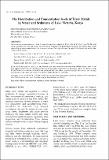| dc.description.abstract | The water and bottom sediments of Lake Victoria (Kenya) were analysed for AI, Fe, Mn, Zn, Pb, Cu, Cr and Cd. The total metal concentrations were determined and their mean variations and distributions discussed. The bottom lake waters showed higher concentration levels than the surface waters. The range of values (in mg/l) in the bottom and surface lake waters were as follows:
Surface Waters: Al(0.08 - 3.98), Fe(0.09 - 4.01), Mn(0.02 - 0 10), 2n(0.01 -0.07),
Pb(O.OOI- 0.007), Cu(not detected - 0.006), Cr/not detected - 0.0(4).
Bottom Waters: Al(0.10 - 6.59), Fe(0.23 - 9.64), Mn(0.04 - 0.39),
2n(0.01- 0.08), Pb(0.002 - 0.009), Cu(not detected - 0.03), Cr(not detected -0.002).
River mouths and shallow areas in the lake showed higher total metal concentrations than offshore deeper areas. Apart from natural metal levels, varied urban activities and wastes greatly contribute to the lake metal pollution as shown by high Pb and Zn levels in sediments, around Kisumu and Homa Bay areas. Other comparatively high values and variations could be attributed to the varied geological characteristics of the lake and its sediments. Compared to the established W.H.O (1984) drinking water standards manganese, aluminium and iron levels were above these limits whereas zinc, lead, chromium, copper and cadmium were below. | en_US |

